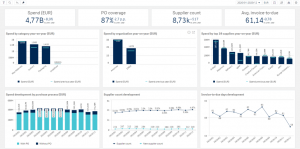
In this post, you will learn about 5 Ws of spend analytics. In case you are a procurement professional looking to understand use cases related to spend analytics, you may find this post to be very useful. In simple words, spend analytics is about extracting insights from spend in different procurement categories.
What are we spending on?
First and foremost, it is important to get visibility on what items are we spending on. This can be achieved using a dashboard. This form of analytics is also called descriptive analytics. Analyzing item spends can be termed as Item spend analytics. The items can be related to direct or indirect procurement. Indirect materials are those which are not directly related to the core business. For example, items related to the marketing category represent indirect procurement. One can use the data related to item spends for doing inventory forecasting.
The spend which is of interest to many is called tail-spend analysis. One can also run anomalies detection algorithms to find the anomalies spend.
Why are we spending?
Along with what items we need to spend, it is equally important to know why are procuring those items. What is the business impact of buying those items?
When are we spending?
Another important thing to consider is the timing for purchase. Many times, it is found that many spends are termed as maverick spend as they are done because there is money left in the budget plan.
Where are we spending?
It is equally important to understand whether the items purchased from suppliers come from the region which is most cost-effective.
Whom are we spending with?
Finally, it is important to understand the suppliers with whom the items are procured. This is related to supplier management. The aspects of supplier diversity come into the picture based on the law of the land. The following are some problems that can be solved using advanced analytics (machine learning)
- Which is/are the most appropriate supplier(s)?
- What is the risk in procuring with a particular supplier?
- Mathematics Topics for Machine Learning Beginners - July 6, 2025
- Questions to Ask When Thinking Like a Product Leader - July 3, 2025
- Three Approaches to Creating AI Agents: Code Examples - June 27, 2025
I found it very helpful. However the differences are not too understandable for me